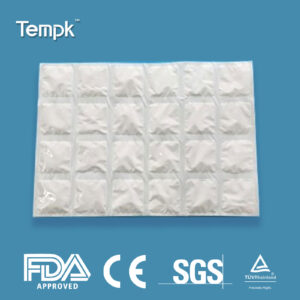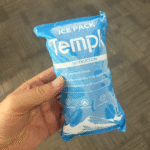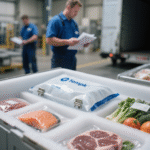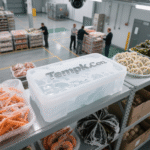حزمة الثلج الجاف 24 الخلايا: What Works in 2025?
إذا قمت بشحن تلاميل, أ حزمة الثلج الجاف 24 الخلايا gives long, even cooling with fewer leaks and simpler compliance than solid dry ice. Use it to keep food and pharma in range while avoiding CO₂ hazards and extra paperwork. Expect 8–24 hours per sheet in quality insulation, then scale by lane hours, موسم, and product mass. This consolidated article merges and upgrades your three drafts for 2025 on‑page SEO and clarity.
-
What is a dry ice pack 24 الخلايا? Clear definition plus ideal use cases for chilled and frozen lanes.
-
How long do 24‑cell sheets last? Practical rules of thumb using parcel profiles.
-
How do you pack it safely? A 7‑step SOP you can train this week.
-
When to choose it vs CO₂ dry ice or gel packs? A comparison you can use in bids.
What is a dry ice pack 24 cells—and when should you use it?
إجابة مباشرة: A dry ice pack 24 cells is a reusable polymer sheet that hydrates into 24 sealed cells; it is not solid CO₂ dry ice. Use it when you need stable cold near 0 °C for 24–36 hours without Class 9 hazmat steps. It stays flexible when frozen, wraps odd shapes, and reduces voids for steadier temperatures.
Expanded explanation:
“24 cells” describes a 4×6 grid that swells during hydration. The grid spreads refrigerant across the surface, increasing contact and reducing hot spots. Unlike CO₂ dry ice at −78.5 °C, polymer sheets melt near 0 °C, which protects freeze‑sensitive goods like greens, المشروبات, and many biologics. For deep‑frozen or very long lanes, you may still prefer true dry ice, but for most overnight food routes, 24‑cell sheets balance safety, يكلف, and simplicity.
How long do 24‑cell ice sheets last in real lanes?
تفاصيل:
ابدأ مع 8–12 hours per sheet in EPS 1.5″ at room‑temp lanes. Add hours with better insulation (PUR/VIP) and full “wrap & cap” placement. Subtract time for summer heat or loose packing. Use data loggers against parcel profiles that model courier systems. في الممارسة العملية, two to four sheets in a tight pack‑out often cover 24–36 hours.
| Pack‑out Factor | Typical Range | Lane Effect | ماذا يعني هذا بالنسبة لك |
|---|---|---|---|
| Insulation R‑value | EPS 1.5″ → VIP | +4–12 hours | Stronger walls slow heat gain |
| Contact area | Bottom‑only → 360° wrap | +25–50% hold | Surround the payload to cut hot spots |
| الحرارة المحيطة | 20–30 °C → 35+ °C | −3–8 hours | Add a sheet or upgrade insulation |
نصائح عملية يمكنك استخدامها اليوم
-
ما قبل الشرط: Chill product and shipper so the sheet cools your lane, not your box.
-
Wrap, don’t stack: Place one under, one around sides, one on top for 360° coverage.
-
Trim to fit: Cut along seams when dry or semi‑hydrated; sleeve edges to stay tidy.
قضية: A meal‑kit brand replaced two gel bricks with two حزمة الثلج الجاف 24 الخلايا sheets and tighter void fill. Warm‑arrival complaints fell 28% in July with no rise in freeze damage.
How to pack a dry ice pack 24 cells safely and consistently?
إجابة مباشرة: Hydrate fully, freeze flat 24–48 hours, and place sheets around—not just under—your goods. If using polymer sheets alone, hazmat labels are not required. If adding any solid dry ice, keep vent paths and mark UN 1845 مع صافي كجم.
Expanded explanation:
Safety starts with full hydration; incomplete cells underperform. Freeze flat for uniform thickness and better contact. During pack‑out, think “heat has many doors”—close them with side wraps, top caps, and tight void fill. When you combine sheets with CO₂ dry ice, switch to Class 9 practices and vent the outer box to prevent pressure build.
7‑step SOP for a dry ice pack 24 الخلايا
-
Hydrate in warm water; scrunch until bubbles stop.
-
Drain and pat dry; avoid oversoaking.
-
Freeze flat at ≤ −18 °C for 24–48 hours.
-
Pre‑chill payload and shipper interior.
-
Load “wrap & cap”: قاع + الجانبين + top contact.
-
Seal inner liner; keep outer ventable if CO₂ is added.
-
Document pack‑out; drop a logger for validation.
| خطوة | لماذا يهم | Good looks like | Your outcome |
|---|---|---|---|
| Full hydration | Max capacity | No soft cells | عقد أطول |
| Flat freeze | Even contact | Uniform thickness | Fewer hot spots |
| Wrap & cap | Higher contact | 360° coverage | Smoother temps |
حزمة الثلج الجاف 24 cells vs CO₂ dry ice vs gel packs—what should you choose?
إجابة مباشرة: Use a dry ice pack 24 cells for chilled or soft‑frozen goods and regulatory simplicity; use CO₂ dry ice for ultra‑cold or very long lanes; use gel bricks for short, low‑risk hops.
Expanded explanation:
Polymer sheets excel where freeze damage is risky and returns matter. True dry ice wins when you must hold ≤ −20 °C for days or expect delays. Gel bricks are cheap and familiar but offer shorter hold and less flexibility.
| Need | Best refrigerant | Why it fits | المراقبة |
|---|---|---|---|
| 2–8 °C biologics, ينتج | حزمة الثلج الجاف 24 الخلايا | Melts near 0 °C; protects against over‑freezing | ما قبل التعرّف; ملء باطل ضيق |
| بوظة, long hot lane | كوك جاف الثلج الجاف | −78.5 °C deep cold; long buffer | و 1845 تسميات; تنفيس |
| Short deli kits | Gel bricks | أدنى تكلفة; بسيط | Condensation; shorter hold |
| 36–48 h frozen | هجين: sheets + co₂ | Sheets stabilize; dry ice extends | وزن, تسميات, تمرين |
How many dry ice pack 24 cells do you need for your box?
إجابة مباشرة: Baseline one sheet per 5–8 L internal volume for ~24 h in moderate weather, then adjust for insulation, موسم, and porch time.
Expanded explanation:
Use this as a pre‑OQ estimator, then tune with logger data. Increase count in summer, add side wraps to boost contact area, and upgrade insulation for longer lanes.
Quick planner (copy‑paste friendly)
مثال
A 20 L box, 26 h hot lane, EPS, 360 wrap → baseline 3 → +1 (ح>24) +1 (حار) = 5 sheets. Validate before rollout.
2025 trends in dry ice pack 24 cells and cold‑chain packaging
نظرة عامة على الاتجاه:
في 2025, teams favor حزمة الثلج الجاف 24 الخلايا for reusable flexibility and clearer rules. Parcel testing under common profiles is becoming standard, while hybrid pack‑outs (sheets plus small CO₂ charges) grow in frozen D2C. Compliance checklists emphasize UN 1845 net‑weight marking and venting whenever CO₂ is used.
آخر تقدم في لمحة
-
Reusable focus: 4‑ply, cut‑to‑fit designs extend life and reduce waste.
-
Validation culture: More shippers log every season and zone, then right‑size sheet count.
-
Hybrid growth: Sheets stabilize near product while a small dry‑ice slab protects headspace.
نظرة السوق:
Direct‑to‑consumer frozen foods and meal kits are expanding. Brands that standardize seasonal pack‑outs and log results cut spoilage and shipping claims while keeping materials lean.
الأسئلة الشائعة
Is a dry ice pack 24 cells the same as real dry ice?
لا. It is a hydrated polymer sheet with 24 sealed cells. Real dry ice is solid CO₂ at −78.5 °C and requires Class 9 labels and UN 1845 net weight for air moves.
How long will a 24‑cell sheet last?
Plan 8–24 hours per sheet depending on insulation, contact area, الحرارة المحيطة, وكتلة الحمولة النافعة. Use two to four sheets for many 24–36 h lanes.
Can I cut a 24‑cell sheet?
نعم. Cut along seam lines when dry or partially hydrated. Sleeve exposed edges to keep the pack tidy.
Do I need hazmat labels?
Not for polymer sheets alone. If you add any CO₂ dry ice, mark UN 1845 with net kg and keep the package ventable.
What size box works best with 24‑cell sheets?
Small to medium shippers benefit most. Sheets wrap irregular items, reducing voids and improving hold time.
ملخص & التوصيات
النقاط الرئيسية:
أ حزمة الثلج الجاف 24 الخلايا delivers reusable, flexible cold without CO₂ hazards. Start with one sheet per 5–8 L for ~24 h, use 360° wrap for steadier temps, and validate with loggers. For ultra‑cold or multi‑day lanes, add or switch to CO₂ dry ice and follow UN 1845 practices.
الخطوات التالية (action plan):
-
Map lane hours and porch time by zone.
-
Pilot two pack‑outs (winter vs summer) and log.
-
Standardize a 7‑step SOP and seasonal sheet counts.
-
If using CO₂, train on net‑kg marking and venting.
CTA: Get a lane‑specific 24‑cell pack‑out plan and a test‑ready bill of materials.
حول Tempk
We design validated cold‑chain pack‑outs for food and life science brands. Our engineers build 24‑cell sheet configurations and CO₂ dry‑ice solutions, then verify them with parcel‑style testing. We operate ISO‑certified facilities with rigorous QA and provide clear SOPs your team can train quickly. Typical clients cut “soft arrival” rates by 30–60% within one season.
Ready to upgrade?
Contact our specialists for a lane audit and a print‑ready SOP you can deploy this week.
























